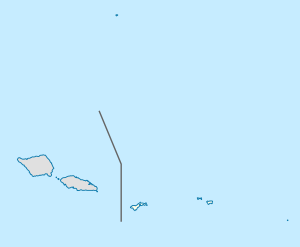Malaeloa/Ituau, American Samoa
Itūʻau | |
|---|---|
Village | |
| Etymology: Samoan: "War Side" | |
| Coordinates: 14°21′05″S 170°46′55″W / 14.35139°S 170.78194°W | |
| Country | |
| Territory | |
| Island | Tutuila Island |
| Named for | Samoan Mythology |
| Area | |
| • Land | .23 sq mi (0.6 km2) |
| Population (2020) | |
• Total | 424 |
| Time zone | UTC−11 (Samoa Time Zone) |
| ZIP Code | 96799 |
| Area code | +1 684 |
Itūʻau, together with Aitūlagi, make up the village of Malaeloa (long ceremonial-green).
Aitūlagi is the name of the famed family of high orator chiefs (tama matua)[1] from the Leāsina county.
Itūʻau along with the villages of Fūtiga, Taputimu and Vailoatai form the itūmalo (county/district) o Tuālātai.
Although Itūʻau and Aitūlagi align themselves with different counties, today they operate together in many respects as one village under the name of Malaeloa.
Tutuila Deed of Cession
[edit]Amituanaʻi of Itūʻau was a signatory to the Tutuila Deed of Cession of 1900.[2]
Etymology
[edit]Itūʻau can literally be translated as "war side".[3] The itūʻau and the alātaua (war path) were roles assumed by allied villages or districts during times of conflict. This was a common practice throughout pre-contact Samoa,[4][5] with its roots in the first Mālietoa government.[6] The function of the itūʻau role can be described as a "controller of troops",[6] whereas the alātaua role can be described as a "director of wars".[6] These functions were carried out by the tulafale (talking chiefs) of the villages or districts designated with these respective roles.[3]
The name of the village, Malaeloa, is derived from the Samoan language and translates into English as “Long malae".[7]
Historical Sites
[edit]The Malaeloa Itūʻau Olo Site (or defensive fortification), which was nominated for the National Register of Historic Places in 2015,[8] is supported by Samoan cultural histories and oral traditions relating to interregional conflicts and defenses against cannibalism during pre-contact periods. It was built to protect villagers from Tuifeʻai, the legendary cannibal king of Tutuila, and his aumaga (army).[9]
Demographics
[edit]| Year | Population[10] |
|---|---|
| 2020 | 424 |
| 2010 | 550 |
| 2000 | 627 |
| 1990 | 523 |
| 1980 | 467 |
References
[edit]- ^ Sunia, Fofo I.F. (2009). A History of American Samoa. Amerika Samoa Humanities Council. Page 35. ISBN 9781573062992
- ^ Sunia, Fofo I.F. (2009). A History of American Samoa. Amerika Samoa Humanities Council. Page 363. ISBN 9781573062992
- ^ a b Maliko, Tavita (2012), O le Soga'miti, PHD Thesis, Page 140
- ^ Williamson, R. W. (1967). The Social and Political Systems of Central Polynesia. Netherlands: Anthropological Publications, Page 82
- ^ Turner, G. (1884). Samoa, a Hundred Years Ago and Long Before: Together with Notes on the Cults and Customs of Twenty-three Other Islands in the Pacific. United Kingdom: Macmillan, Page 189
- ^ a b c "Tumua and Pule. — Construction and significance in the Political history of Samoa | NZETC". nzetc.victoria.ac.nz.
- ^ Churchill, W. (1913). "Geographical Nomenclature of American Samoa". Bulletin of the American Geographical Society, 45(3), page 192. Retrieved on December 6, 2024, from https://doi.org/10.2307/199273.
- ^ "National Register of Historic Places; Notification of Pending Nominations and Related Actions". Federal Register. 24 December 2015. Retrieved 22 March 2022.
- ^ "Malaeloa Olo, U.S. National Register of Historic Properties, Accepted 1-5-2016". National Park Service. Retrieved 22 March 2022.
- ^ "American Samoa Statistical Yearbook 2015" (PDF). American Samoa Department of Commerce.

